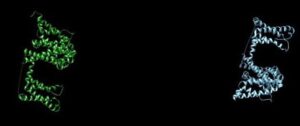This was my second and last week virtually working with Ph.D. student Brandon Harris and Dr. Vladimir Yarov-Yarovoy at the University of California, Davis School of Medicine, in the Department of Physiology and Membrane Biology.
We began the week with a presentation by Dr. Yarov-Yarovoy in which he discussed the big picture of protein modeling. He explained with an interactive video how when the ligand (could be a drug, hormones, or neurotransmitters) binds to a specific part of the protein, it could lead to a decrease in certain functions of the cell. Dr. Yarov-Yarovoy explained again the importance of protein modeling and the understanding of ion channels to create more effective drugs. The presentation made me even more interested in the functions that medicine takes and how it could positively and negatively affect our bodies.
This week I began working with the relaxed protocol. This protocol is what helps decrease the energy of the protein by ‘folding’ the structure, which makes it more stable and also more likely to exist naturally. I began relaxing the protein we have been working with for the past week, 6uz0. After relaxing the protein, I began to use the GALigandock program. What GALindock does is called ligand docking. Ligand docking is the process of predicting where the ligand will bind to the protein. GALindock makes around 1,000 predictions. After the program ran, we would have interpreted the data, but we ran out of time. However, Brandon taught us how we would interpret the data and choose the best cluster of information as the best location of the binding ligand for the protein. After relaxing and running GALigandock for 6uz0, I did the same for the two proteins that were assigned to me 6c1m and 6c1k (6c1m to the left and 6c1k to the right).
As this section of the internship ended, I realized how much I have learned not only about the biology of proteins but also computational biology. I am very excited about the second section of the internship with Dr. Igor Vorobyov and Slava Bekker, which will focus more on biophysics. I am excited to learn more about that specific field as much as I learned about computational biology with Brandon Harris and Dr. Yarov-Yarovoy these past two weeks.
Dr. Yarov-Yarovoy invited us to continue working with Brandon Harris after our second section of the internship for the rest of the summer. I am very excited about that opportunity, and I hope I continue to broaden my knowledge of computational biology and proteins.
To any reader interested in the things that Eliram Reyes-Powell, Kelly Stellmancher, and I have been doing for the past weeks, a great way to explore the field would be by downloading the game Foldit. Foldit can give you an introductory idea of the folding process and also the structure of proteins, plus it is fun!
This week I was so busy trying to understand all the different commands that we were performing that I did not have much free time, but, as always, I played a lot with my dog and Facetimed my friends.


There are no comments published yet.